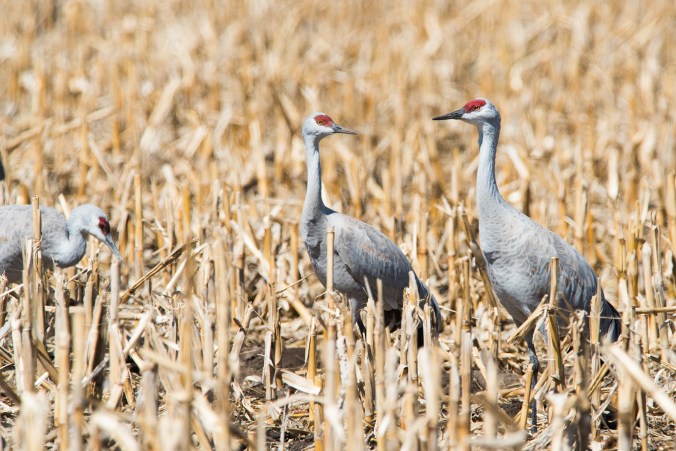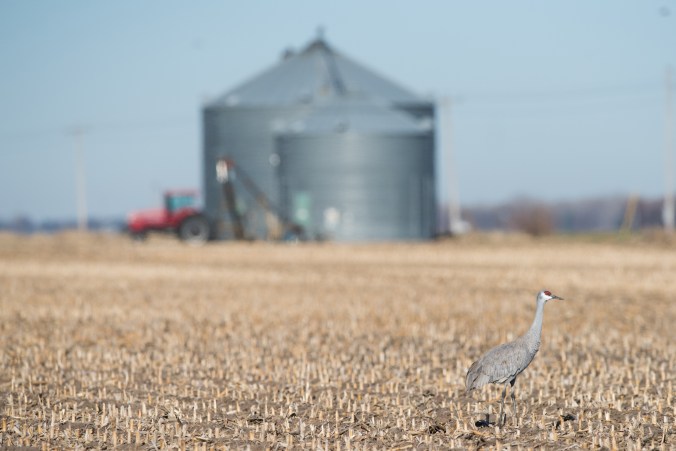It’s been gray, snowy and cold here at Quiet Farm this weekend, and I think I can confidently speak for most of the United States when I say we are ready for spring. Between polar vortexes and bomb cyclones and Snowmageddons and white-knuckle drives over mountain passes and goodness knows what other chilliness, this winter has been…lengthy. Despite our grumbling, though, we are of course entirely dependent on that winter moisture for our spring and summer irrigation, so we are truly grateful. And all that snow and mud means no outdoor projects, so we have more time to read, too!
Month: March 2019
The cranes are here!

There are so many benefits to living where we do now, including but not limited to lots of fresh, local fruit in the summer. But just now, coming off a long, dark winter, we’re most excited to see one of the true harbingers of spring: the greater sandhill crane on its annual migration between New Mexico and the Yellowstone ecosystem (northern Idaho and Montana).

Greater sandhill cranes are big, gorgeous, elegant birds; adults stand about four feet tall and have a six-foot wingspan. They’re most easily recognized by their sooty gray coloring and the red patches on their eyes and head, and that they flock by the thousands. Their plumage can take on a rusty red sheen, because they often preen by rubbing their feathers with iron-rich mud.

In Colorado, a flock of about twenty thousand birds gathers in February and March in the San Luis Valley, where they rest and forage before heading further north. About five thousand of these birds then make their way straight over Delta County, where we live, often stopping at Fruitgrowers’ Reservoir just to the east of our farm.

Greater sandhill cranes are the oldest birds still living today; fossil records from two and a half million years ago indicate that they’ve changed hardly at all. Rock art and other artifacts in the San Luis Valley show that cranes have been important to the region’s people for as long humans have inhabited the area. Their annual migration is a sure sign that we’ve survived another winter, and spring is on its way.

Sandhill cranes sleep in shallow, calm water to keep themselves safe from predators, so a reservoir like Fruitgrowers’ is a perfect stopover location. These birds are opportunistic feeders; they most often eat plants and grains, but they’ll also feast on invertebrates and small mammals, if available. The Western Slope and the San Luis Valley offer thousands of acres of fallow cornfields in which to forage.

The cranes are most active at dawn and dusk when they “commute” to and from their daytime feeding grounds. The population along the Platte River in Nebraska is so large – half a million birds – that the cranes’ noise can drown out normal conversation. Sandhill cranes have a distinctive call, and the birds can frequently be heard even when they can’t be seen. The cranes are often spotted along the same transitory route in fall, but they rarely stop over in Delta County. Local experts believe this is because the reservoir is dry in the autumn, so there is no place to for the birds to sleep safely.

Although sandhill cranes aren’t quite as demonstrative as the famous dancing prairie chicken, the birds will perform for their prospective mate. Sandhill cranes mate for life and can live up to twenty years, a remarkable lifespan for a wild bird. These cranes don’t nest here in Colorado but instead lay their eggs up north; the female typically lays two eggs and the male guards the nest. It takes a month for the eggs to hatch and two months for the chicks to reach maturity, although only one chick usually survives.

We are thrilled to share space with these magnificent birds, and we look forward to their migration every spring.
P.S. If you’re interested in seeing the cranes in huge numbers, the two best locations are Monte Vista in southern Colorado and along the Platte River in central Nebraska. Both are definitely worth the trip!

How to grow microgreens
We’re still firmly in winter’s icy grip here on Colorado’s Western Slope, and there’s no better cure for spring fever than growing something indoors. Let’s learn how to grow microgreens!

Microgreens sound fancy and expensive, but really they’re just tiny versions of things we already eat, like kale, radishes and beets. They are packed with nutrition, super flavorful, quick and easy to grow with no special equipment needed and absolutely gorgeous on the plate. What more could you ask from an indoor crop?